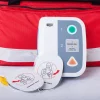Recent Post
- What Maintenance Is Required for an AED: Everything You Need To Know
November 14, 2025  Could You Recognise the Signs That Someone Needs a Defibrillator?
Could You Recognise the Signs That Someone Needs a Defibrillator?
September 12, 2023
Given the crucial role AEDs (Automated External Defibrillators) play in emergency preparedness, it’s essential to ensure that every component meets safety standards and is readily available for immediate use. This includes ensuring that the defibrillator’s electrode pads are functional, adhesive, and capable of delivering a safe and effective shock, and ready for immediate use in an emergency.
Fortunately, this article will cover everything you need to know about electrode pads, including what they are, why and when they expire, and signs that they need replacing. It will also provide a few other helpful points and best practices for keeping your AED in optimal condition.
What are AED Pads?
Otherwise known as electrode pads, AED pads are adhesive pads that are connected to a defibrillator and attach to the bare chest of an individual who needs defibrillation during cardiac arrest emergencies. They are an essential component of a defibrillator, transmitting the electric shock to the heart while allowing the device to track the heart’s rhythm. Because of this, an AED cannot function without them.
Why Do AED Pads Expire?
AED pads are made of several components, including metal, plastic, and adhesive gel, each of which plays a role in ensuring the pads function effectively.
The majority of the time, it is the gel that deteriorates, necessitating the replacement of the pads, as over time, the gel can dry out and become brittle, compromising both adhesion and the delivery of a potentially lifesaving shock.
Signs AED Pads Need A Replacement
If you’re unsure whether your AED pads need replacing, look for the following common indicators that it’s time for a new set:
- Expiration Date on the Packaging Has Passed: This one is an easy one. If you check the expiry date, and it has passed, it’s time to replace your AED pads.
- The Pads Are Visibly Damaged: Check for any signs of wear and tear, such as cracks, tears, or dried-out areas on the pads. This also includes if the pads’ packaging/seal has been opened, either intentionally or not, but the pads have not been used. Open packaging exposes the pads to air and, over time, may cause the pads to dry out prematurely, meaning they may not stick properly in an emergency.
- The Pads Are No Longer Sticky: Adhesive pads must stick securely to the chest to work effectively. If they aren’t sticky, replace them.
- The Pads Have Been Used: AED pads are single-use. Once applied in an emergency, they must be replaced.
- You Notice A Connectivity Error: Some AEDs will alert you if the pads are not correctly connected or detected. This could indicate a problem, and replacement may be necessary. Please check with the manufacturer if unsure. Most AEDs require the pads to remain connected to the device at all times to ensure the device is ready for immediate use in a cardiac arrest emergency.
At Priority First Aid, we recommend conducting regular checks of your AED pads, inspecting all components as part of your first aid compliance protocols.
What Happens If You Don’t Replace AED Pads?
One may assume that because an AED has never been used, the pads don’t need to be replaced. However, this is far from the case. If AED pads are not replaced by the expiration date, their effectiveness can be significantly compromised. Over time, the adhesive gel and conductive materials can deteriorate, leading to a range of issues, including:
- Reduced Adhesion: Over time, the adhesive on AED pads can dry out or lose its tackiness. If the pads do not stick firmly to the chest, they may shift during use or fail to make proper contact, which can prevent the AED from delivering a shock effectively when it’s needed most.
- Inaccurate Rhythm Analysis: AEDs rely on good contact with the skin to accurately detect the heart’s electrical signals. Expired or degraded pads may not transmit these signals correctly, causing the AED to misread the heart rhythm and potentially delay or prevent the delivery of a life-saving shock.
- Reduced or Ineffective Shock Delivery: The conductive gel in AED pads ensures the electrical shock passes efficiently through the chest to the heart. If the gel has dried out or the pads are damaged, the shock may be weaker than intended or fail to reach the heart properly, reducing the chances of restoring a normal rhythm.
- Potential for Burns or Injury: Worn-out pads can create uneven electrical contact, which may cause localised burns, skin irritation, or other injuries. Maintaining fresh, effective pads ensures the shock is delivered safely and effectively.
How Often Do AED Pads Need To Be Replaced?
AED pads must be replaced after every use. If unused, they should still be replaced by their expiration date, as most AED pads have a life expectancy of between two and five years from the date of manufacture. It is essential to note that the shelf life of AED pads may vary significantly depending on the manufacturer, so it’s crucial to check the individual product or contact the manufacturer to confirm.
Replacing Your AED Pads
To ensure your AED is fully operational:
- Check Pad Expiry Date: As part of your AED inspection routine, visually inspect the pads to confirm they are within their usable date.
- Order Replacements From the Same Brand as the AED Unit: Using manufacturer-recommended pads ensures compatibility and reliable performance.
- Follow Manufacturer Guidelines for Installation: Proper placement and connection of pads is essential for effective AED operation.
Reach Out To Priority First Aid
If you have any questions about AED pads, how long they are good for, or which ones you should be using, don’t hesitate to contact the Priority First Aid team. We’re always happy to help you determine the right pads for your AED and ensure your equipment is ready when it’s needed most.




